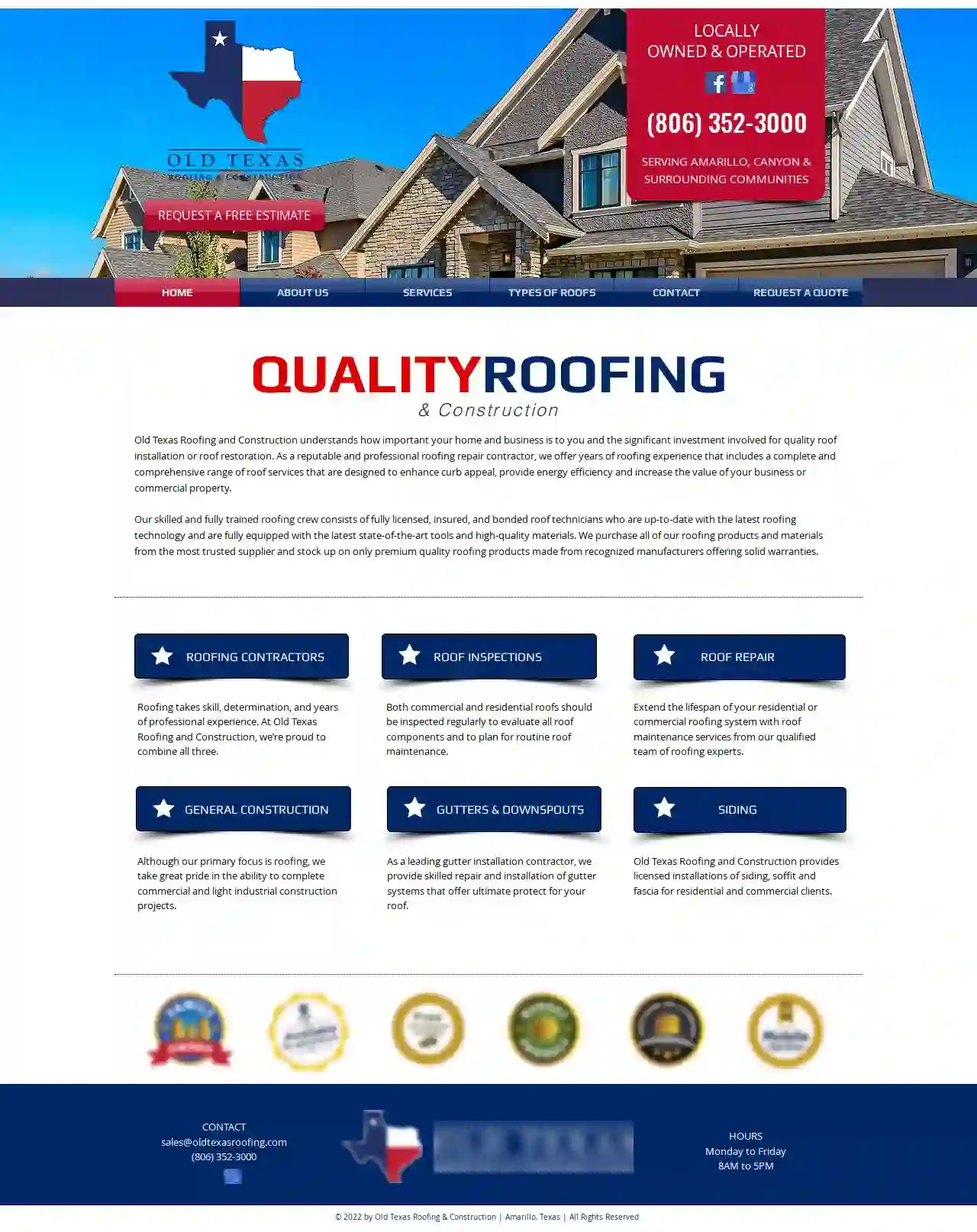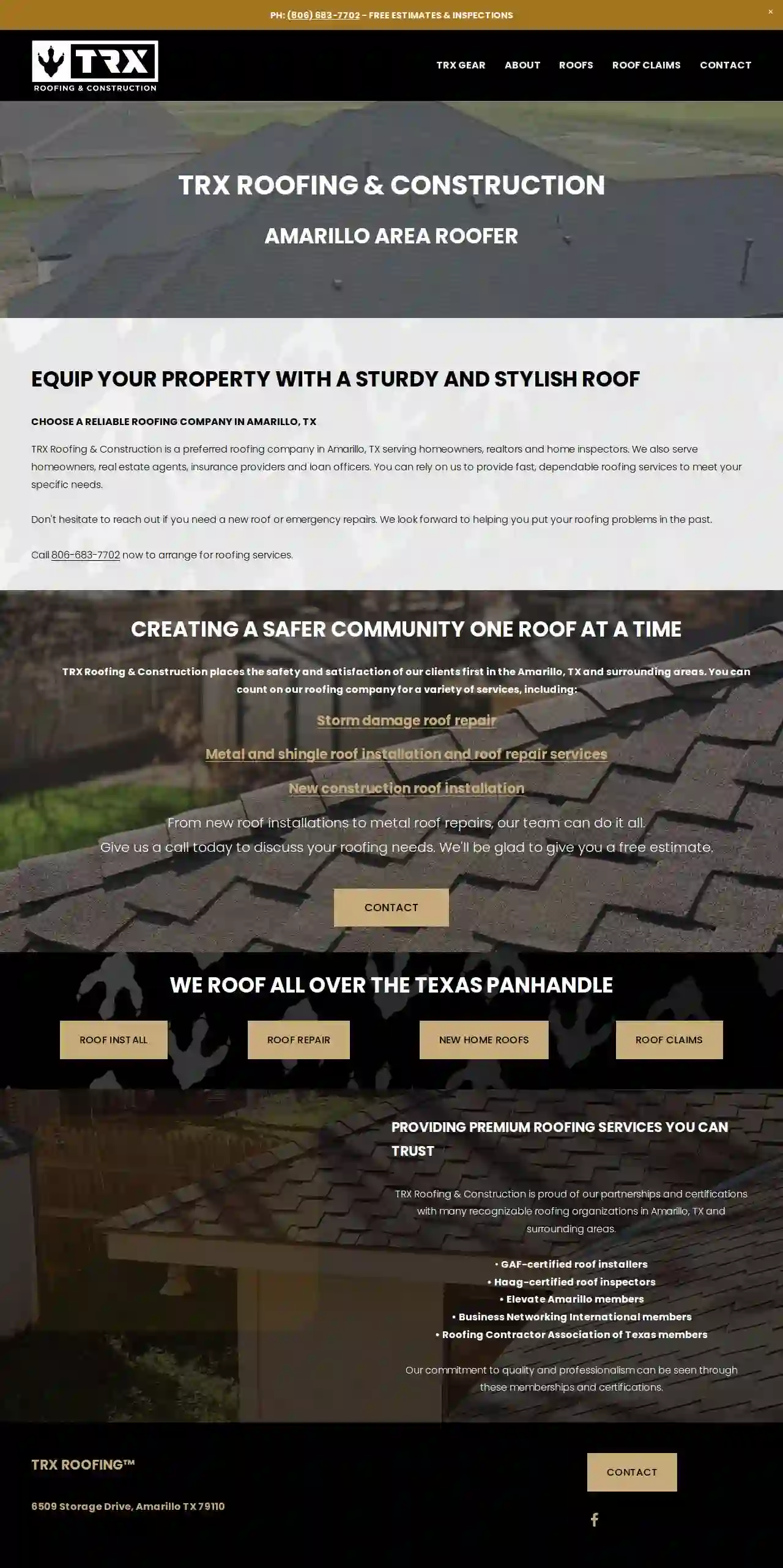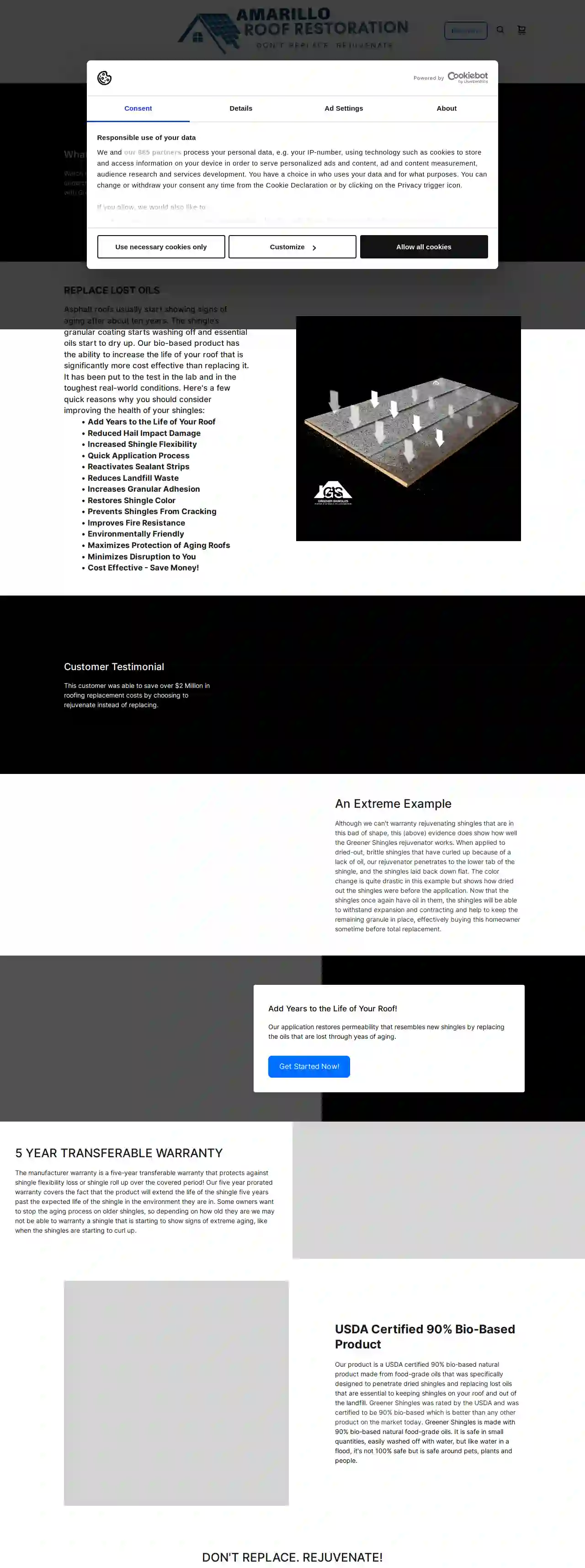Green Roof Installers Amarillo
Find the best Green Roof Installation in Amarillo
Get multiple Green Roof Installers quotes for your project today! Compare profiles, reviews, accreditations, portfolio, etc... and choose the best deal.

Roof Smith
4.9163 reviews6435 S Osage St., Amarillo, 79118, USRoof Smith is a roofing company that serves Amarillo, TX, Lubbock, TX, and Clovis, NM. We offer residential and commercial roofing services, including roof repair, installation, and replacement. Our team of experts works closely with you to ensure your home or business receives strong, reliable, and long-lasting protection. We have three locations in Amarillo, TX, Lubbock, TX, and Clovis, NM, and serve the surrounding areas. Our company is committed to providing top-quality roofing services and courteous customer service. We work with roofs of all kinds, replacing or repairing damages. Whether you are suffering from wind damage, leaks, or parts of your roof have been thoroughly damaged in a storm, our team of experts will work closely with you to make sure your home or business receives the best protection possible.
- Services
- Why Us?
- Our Team
- Testimonials
- Gallery
Get Quote
All Star Sheet Metal & Roofing LLC
4.626 reviews405 Crockett St, Amarillo, 79106, USAll Star Sheet Metal & Roofing LLC has been serving the Amarillo, TX community since 1963. Founded by Bob Hicks, we have maintained a high standard of workmanship for three generations. We offer a wide range of services, including TPO roofing installation, metal roofing installation, reroofing services, roof repair, sheet metal fabrication, and CNC plasma cutting. We also have a sister company, All Star Exteriors, specializing in gutter, siding, and window installation services. Our certified roofing, siding, and gutter contractors have the skills and experience to handle your project from start to finish. We'll help you choose the right materials to ensure your exterior looks exactly how you want.
- Services
- Why Us?
- Our Team
- Testimonials
- Gallery
Get Quote
Old Texas Roofing and Construction
Amarillo, USOld Texas Roofing and Construction understands how important your home and business is to you and the significant investment involved for quality roof installation or roof restoration. As a reputable and professional roofing repair contractor, we offer years of roofing experience that includes a complete and comprehensive range of roof services that are designed to enhance curb appeal, provide energy efficiency and increase the value of your business or commercial property. Our skilled and fully trained roofing crew consists of fully licensed, insured, and bonded roof technicians who are up-to-date with the latest roofing technology and are fully equipped with the latest state-of-the-art tools and high-quality materials. We purchase all of our roofing products and materials from the most trusted supplier and stock up on only premium quality roofing products made from recognized manufacturers offering solid warranties.
- Services
- Why Us?
- Gallery
Get Quote
Accent Roofing of Amarillo, LLC
4.970 reviewsAmarillo, Texas, 610 S Georgia St, 79106, USAccent Roofing of Amarillo has been Roofing in Amarillo Since 2001. Roofing Contractors have a challenge in the Texas Panhandle with the hail damage and high wind damage on roofs. Accent Roofing can inspect your roof and works to insure your roof damage is documented correctly. We are your turnkey contractor for everything you need for your roof. Composition roofs, flat roofs, pvc roofs, metal roofs, and rubber roofs are just a few of the different types of roofs. Whether you have a flat roof, pvc roof, or a composition roof we have you covered. We offer repair services for all types of roofs. Does your home need a new roof or need some work done on the roof to prevent any type of damage to your home? We offer multiple services for your roof and our professional staff is here to help you every step of the way.
- Services
- Why Us?
- Accreditations
- Our Team
- Gallery
Get Quote
TRX Roofing & Construction
522 reviews6509 Storage Drive, Amarillo, 79110, USTRX Roofing & Construction is a preferred roofing company in Amarillo, TX serving homeowners, realtors and home inspectors. We also serve homeowners, real estate agents, insurance providers and loan officers. You can rely on us to provide fast, dependable roofing services to meet your specific needs. Don't hesitate to reach out if you need a new roof or emergency repairs. We look forward to helping you put your roofing problems in the past. TRX Roofing & Construction places the safety and satisfaction of our clients first in the Amarillo, TX and surrounding areas. You can count on our roofing company for a variety of services, including: Storm damage roof repair Metal and shingle roof installation and roof repair services New construction roof installation From new roof installations to metal roof repairs, our team can do it all. Give us a call today to discuss your roofing needs. We'll be glad to give you a free estimate. TRX Roofing & Construction is proud of our partnerships and certifications with many recognizable roofing organizations in Amarillo, TX and surrounding areas: GAF-certified roof installers Haag-certified roof inspectors Elevate Amarillo members Business Networking International members Roofing Contractor Association of Texas members Our company prides itself in its diversity helping its clients with all types of jobs and procedures, including general repairs, replacements and new system installations. If clients are not sure what a certain installation will entail, we will be more than happy to walk their clients through the process, helping them understand the work that is being done. All of the services are competitively priced to provide interested customers with plenty of options when it comes to finding the roofing service that they have always been looking for. All materials chosen for installations are of the highest quality. We utilize high quality shingles and fasteners to make sure that the job lasts as long as it is needed.
- Services
- Why Us?
- Accreditations
- Gallery
Get Quote
Tecta America Amarillo
4.616 reviews2214 S. Lincoln St., Amarillo, 79109, USTecta America CS Amarillo started its journey as “Construction Services” in 1943 in Vernon, Texas. Over the years, Construction Services grew into a specialty contractor, narrowing its focus to all types of commercial roofing, and became known for its capability to handle the more substantial and complex projects. In 1963, the company relocated to its permanent home in Amarillo, Texas. We specialize in the installation of all types of commercial roofing, industrial roofing, re-roofs, metal roofs, leak repairs, preventative maintenance, coatings, inspections, and service, as well as custom sheet metal fabrication. We are available 24 hours a day, 7 days a week, all year long for you. If you have an emergency roofing issue, we will be able to help you out. With Tecta America Amarillo, you can rest assured that your building, and everything inside, will be protected by a properly installed, quality roof. Roofing in Amarillo and the surrounding communities is our specialty. Our continued growth as the commercial roofing industry’s leader allows us to offer the greatest depth of experience, resources, technology, and capabilities available today. We offer a full line of commercial roofing maintenance, repairs & installations, including: Repair & Leak Services Commercial Coatings Roof Asset Mgmt Preventative Maint. Emergency Response Commercial Roofing Architectural Metal Roof Inspections Skylight-Daylight Roof Replacement Customer Service Testimonials
- Services
- Why Us?
- Accreditations
- Our Team
- Testimonials
- Gallery
Get Quote
Amarillo Roof Restoration LLC
123 Main Street, Suite 100, Amarillo, 79106, USAmarillo Roof Restoration is a locally owned and operated business serving the Amarillo, Texas area. We specialize in roof repair, replacement, and restoration services for residential and commercial properties. Our team of experienced and certified roofers is dedicated to providing high-quality workmanship and exceptional customer service. We use only the best materials and techniques to ensure that your roof is protected from the elements and lasts for years to come. Whether you need a minor repair or a complete roof overhaul, Amarillo Roof Restoration is the trusted name in Amarillo for all your roofing needs. We understand that your roof is one of the most important investments you make in your home or business. That's why we are committed to providing you with the highest level of service and expertise. We offer free estimates and competitive pricing, and we work with you every step of the way to ensure that your project is completed to your satisfaction. Contact us today to schedule a free consultation and learn more about how Amarillo Roof Restoration can help protect your property.
- Services
- Why Us?
- Accreditations
- Our Team
- Testimonials
Get Quote
Amarillo TX Roofing Pros
57 reviews123 Main St, Amarillo, TX, 806, USAmarillo TX Roofing Pros is your premier roofing contractor serving Amarillo, TX and the surrounding areas. With a commitment to excellence, we specialize in providing top-notch solutions tailored to meet your needs. Trust us for dependable, efficient, and durable services that safeguard your property for years to come. As homeowners ourselves, we understand that investing in a new roof is a substantial decision. With countless contractors, choosing the right one is crucial. We take pride in being the best choice for your needs. Our commitment is to provide you with peace of mind by delivering top-notch quality roofs that align with your budget. Trust us to be your reliable partner, ensuring your home gets the attention and expertise it deserves. Your satisfaction is our priority, and excellence is our guarantee. Call us today at 806-424-4171. Local Amarillo Roofers. Our company is built on trust and transparency. Unlike the horror stories you may have heard, we are not here to cut corners or compromise on quality. We're proud to be 100% local, rooted in our community. Our passion lies in executing projects the RIGHT WAY. Expect meticulous workmanship, top-notch materials, and genuine honesty because your satisfaction is our priority. When you choose us, you choose a partner you can rely on. Quality Work. Our proven track record sets us apart in the industry. With the highest quality materials, we ensure your new roof stands the test of time. Our skilled team can handle any project with expertise. Competitive Prices. While some contractors entice with exceptionally low quotes, the trade-off often results in subpar work. That's not the case with us. We ensure competitive pricing, aligned with other providers, all while upholding our commitment to top-notch quality. Professional and Honest. Our teams maintain professionalism and honesty from initial contact through the entire process to ensure transparent communication. We prioritize constant interaction to address your questions and provide insights for a strong, long-lasting relationship.
- Services
- Why Us?
- Gallery
Get Quote
Norton Roofing
44 reviews512 Northeast 2nd Avenue, Amarillo, 79107, USProtect Your Home with Quality Roofing. We provide durable roofing solutions that keep your home safe and secure for years to come. Schedule A Consultation Now. About Norton Roofing: Our Story. Norton Roofing is a local and family-owned roofing business that has been providing residential roofing and commercial roofing services to the Amarillo community for over 35 years. Greg Norton started this business with a passion for providing quality roofing services at affordable prices. Find out more about us. Our Mission: Our mission is to provide exceptional roofing services to our customers while maintaining the highest level of integrity and professionalism. Let our team of experts be your advocate and guide you through the complicated insurance claims process. We strive to exceed our customers' expectations and leave them completely satisfied with our work. That's why all of our projects are covered by our workmanship guarantee. Get it Done Right the First Time. Every time. Satisfied Clients. Happy Customers. Contact Us: Ask Us About Our Free Estimates! Name: Email*: Phone: Address (Street, City, Zip Code): Attach Files: Attachments (0) Send. This site is protected by reCAPTCHA and the Google Privacy Policy and Terms of Service apply.
- Services
- Why Us?
- Accreditations
- Our Team
- Gallery
Get Quote
Quality Assurance Roofing
563 reviews8910 SW 34th Ave Suite 400, Amarillo, 79124, USQuality Assurance Roofing is a licensed roofing contractor serving Amarillo, TX and surrounding areas. We specialize in residential and commercial roofing services, including roof repairs, replacements, and storm damage restoration. Our team of highly trained and certified roofing contractors provides reliable and knowledgeable service throughout the entire insurance claim process. As an Owens Corning Platinum Preferred Contractor and a CertainTeed SELECT ShingleMaster™, we are committed to using the highest quality materials and workmanship to ensure a durable and long-lasting roof for your home or business.
- Services
- Why Us?
- Testimonials
- Gallery
Get Quote
Over 17,196+ Roofers on our platform
Our roofing experts operate in Amarillo and beyond!
Roofyng.com has curated and vetted the Best Roofing Contractors arround Amarillo. Find the most trustworthy pro today.
Green Roof Installation FAQs
- Roof size and complexity
- Type of green roof system (intensive vs. extensive)
- Plant selection
- Accessibility of the roof
- Labor costs in your region
- Watering (if needed)
- Fertilizing
- Weeding
- Pruning
- Inspections
- Waterproofing Membrane: A waterproof barrier to protect the building from water intrusion.
- Drainage Layer: Allows excess water to drain away from the roof.
- Growing Medium: A lightweight soil mix specifically designed for rooftop gardens.
- Vegetation: Plants chosen for their suitability to rooftop conditions.
How much does a green roof cost to install in the USA?
Are green roofs expensive to maintain?
What is a green roof, and how does it work?
Do green roofs attract pests?
How much does a green roof cost to install in the USA?
- Roof size and complexity
- Type of green roof system (intensive vs. extensive)
- Plant selection
- Accessibility of the roof
- Labor costs in your region
Are green roofs expensive to maintain?
- Watering (if needed)
- Fertilizing
- Weeding
- Pruning
- Inspections
What is a green roof, and how does it work?
- Waterproofing Membrane: A waterproof barrier to protect the building from water intrusion.
- Drainage Layer: Allows excess water to drain away from the roof.
- Growing Medium: A lightweight soil mix specifically designed for rooftop gardens.
- Vegetation: Plants chosen for their suitability to rooftop conditions.